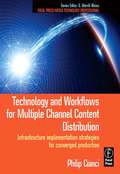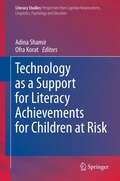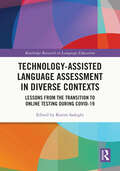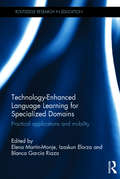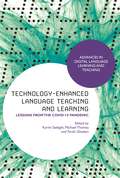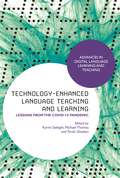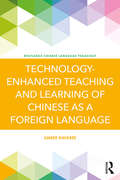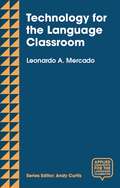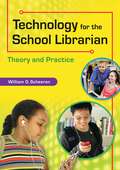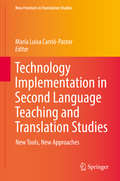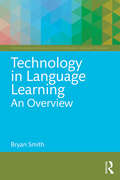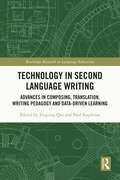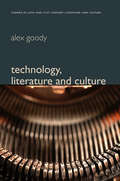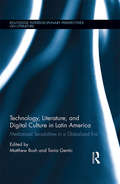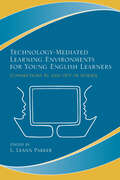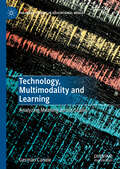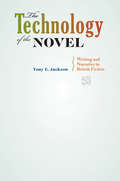- Table View
- List View
Technology and Workflows for Multiple Channel Content Distribution: Infrastructure implementation strategies for converged production
by Philip J. CianciThis book addresses the emergence of multi-channel broadcasting. Televisions, PC's, handheld and mobile reception devices now all receive content hat was once solely distributed by broadcast TV.No book currently on the market addresses the production infrastructure necessary to efficiently produce content for multi-channel delivery to a variety of reception platforms/devices.Readers will acquire an overview of not just the technology, but processes that impact the creative process and new cross-platform advertising sale/buy model.
Technology as a Support for Literacy Achievements for Children at Risk (Literacy Studies #7)
by Adina Shamir and Ofra KoratPresenting cutting-edge studies from various countries into the theoretical and practical issues surrounding the literacy acquisition of at-risk children, this volume focuses specifically on the utility of technology in supporting and advancing literacy among the relevant populations. These include a range of at-risk groups such as those with learning disabilities, low socioeconomic status, and minority ethnicity. Arguing that literacy is a key requirement for integration into any modern society, the book outlines new ways in which educators and researchers can overcome the difficulties faced by children in these at-risk groups. It also reflects the rapid development of technology in this field, which in turn necessitates the accumulation of fresh research evidence.
Technology-Assisted Language Assessment in Diverse Contexts: Lessons from the Transition to Online Testing during COVID-19 (Routledge Research in Language Education)
by Karim SadeghiThis timely collection explores the role of digital technology in language education and assessment during the COVID-19 pandemic. It recognises the unique pressures which the COVID-19 pandemic placed on assessment in language education, and examines the forced shift in assessment strategies to go online, the existing shortfalls, as well as unique affordances of technology-assisted L2 assessment. By showcasing international examples of successful digital and computer-assisted proficiency and skills testing, the volume addresses theoretical and practical concerns relating to test validity, reliability, ethics, and student experience in a range of testing contexts. Particular attention is given to identifying lessons and implications for future research and practice, and the challenges of implementing unplanned computer-assisted language assessment during a crisis. Insightfully unpacking the ‘lessons learned’ from COVID and its impact on the acceleration of the shift towards online course and assessment delivery, it offers important guidelines for navigating assessment in different instructional settings in times of crisis. It will appeal to scholars, researchers, educators, and faculty with interests in educational measurement, digital education and technology, and language assessment and testing.
Technology-Assisted Language Assessment in Diverse Contexts: Lessons from the Transition to Online Testing during COVID-19 (Routledge Research in Language Education)
by Karim SadeghiThis timely collection explores the role of digital technology in language education and assessment during the COVID-19 pandemic. It recognises the unique pressures which the COVID-19 pandemic placed on assessment in language education, and examines the forced shift in assessment strategies to go online, the existing shortfalls, as well as unique affordances of technology-assisted L2 assessment. By showcasing international examples of successful digital and computer-assisted proficiency and skills testing, the volume addresses theoretical and practical concerns relating to test validity, reliability, ethics, and student experience in a range of testing contexts. Particular attention is given to identifying lessons and implications for future research and practice, and the challenges of implementing unplanned computer-assisted language assessment during a crisis. Insightfully unpacking the ‘lessons learned’ from COVID and its impact on the acceleration of the shift towards online course and assessment delivery, it offers important guidelines for navigating assessment in different instructional settings in times of crisis. It will appeal to scholars, researchers, educators, and faculty with interests in educational measurement, digital education and technology, and language assessment and testing.
Technology-Enhanced Language Learning for Specialized Domains: Practical applications and mobility (Routledge Research in Education)
by Elena Martin-Monje Izaskun Elorza Blanca García RiazaTechnology-Enhanced Language Learning for Specialized Domains provides an exploration of the latest developments in technology-enhanced learning and the processing of languages for specific purposes. It combines theoretical and applied research from an interdisciplinary angle, covering general issues related to learning languages with computers, assessment, mobile-assisted language learning, the new language massive open online courses, corpus-based research and computer-assisted aspects of translation. The chapters in this collection include contributions from a number of international experts in the field with a wide range of experience in the use of technologies to enhance the language learning process. The essays have been brought together precisely in recognition of the demand for this kind of specialised tuition, offering state-of-the-art technological and methodological innovation and practical applications. The topics covered revolve around the practical consequences of the current possibilites of mobility for both learners and teachers, as well as the applicability of updated technological advances to language learning and teaching, particularly in specialized domains. This is achieved through the description and discussion of practical examples of those applications in a variety of educational contexts. At the beginning of each thematic section, readers will find an introductory chapter which contextualises the topic and links the different examples discussed. Drawing together rich primary research and empirical studies related to specialized tuition and the processing of languages, Technology-Enhanced Language Learning for Specialized Domains will be an invaluable resource for academics, researchers and postgraduate students in the fields of education, computer assisted language learning, languages and linguistics, and language teaching.
Technology-Enhanced Language Learning for Specialized Domains: Practical applications and mobility (Routledge Research in Education)
by Elena Martín-Monje Izaskun Elorza Blanca García RiazaTechnology-Enhanced Language Learning for Specialized Domains provides an exploration of the latest developments in technology-enhanced learning and the processing of languages for specific purposes. It combines theoretical and applied research from an interdisciplinary angle, covering general issues related to learning languages with computers, assessment, mobile-assisted language learning, the new language massive open online courses, corpus-based research and computer-assisted aspects of translation. The chapters in this collection include contributions from a number of international experts in the field with a wide range of experience in the use of technologies to enhance the language learning process. The essays have been brought together precisely in recognition of the demand for this kind of specialised tuition, offering state-of-the-art technological and methodological innovation and practical applications. The topics covered revolve around the practical consequences of the current possibilites of mobility for both learners and teachers, as well as the applicability of updated technological advances to language learning and teaching, particularly in specialized domains. This is achieved through the description and discussion of practical examples of those applications in a variety of educational contexts. At the beginning of each thematic section, readers will find an introductory chapter which contextualises the topic and links the different examples discussed. Drawing together rich primary research and empirical studies related to specialized tuition and the processing of languages, Technology-Enhanced Language Learning for Specialized Domains will be an invaluable resource for academics, researchers and postgraduate students in the fields of education, computer assisted language learning, languages and linguistics, and language teaching.
Technology-Enhanced Language Teaching and Learning: Lessons from the Covid-19 Pandemic (Advances in Digital Language Learning and Teaching)
by Karim Sadeghi, Michael Thomas and Farah GhaderiThe Covid-19 pandemic has directly impacted the way teachers and learners worldwide teach and learn languages, forcing numerous educational activities in technologically-deprived contexts to stop altogether and those in technologically-rich environments to go online on an emergency basis. This volume provides a collection of theoretical and practical insights into the challenges and affordances faced globally during the pandemic and lessons learnt about the application of digital technologies for language teaching and learning. The chapters explore the vital role of technology in its various forms, including the internet, social media, CALL (Computer-Assisted Language Learning), MALL (Mobile Assisted Language Learning), TALL (Technology Assisted Language Learning) and TELL (Technology Enhanced Language Learning). Topics explored include the new avenues digital technology has opened up for language teachers and learners, options and challenges in applying technology in various contexts, and how the second language education industry could have been adversely impacted at the time of the pandemic without technological affordances. The contributions showcase studies from various geographical contexts, revealing how the global crisis was received and tackled differently in Australia, Hong Kong, Iran, Italy, Japan, New Zealand, the UAE, the UK and the USA.
Technology-Enhanced Language Teaching and Learning: Lessons from the Covid-19 Pandemic (Advances in Digital Language Learning and Teaching)
The Covid-19 pandemic has directly impacted the way teachers and learners worldwide teach and learn languages, forcing numerous educational activities in technologically-deprived contexts to stop altogether and those in technologically-rich environments to go online on an emergency basis. This volume provides a collection of theoretical and practical insights into the challenges and affordances faced globally during the pandemic and lessons learnt about the application of digital technologies for language teaching and learning. The chapters explore the vital role of technology in its various forms, including the internet, social media, CALL (Computer-Assisted Language Learning), MALL (Mobile Assisted Language Learning), TALL (Technology Assisted Language Learning) and TELL (Technology Enhanced Language Learning). Topics explored include the new avenues digital technology has opened up for language teachers and learners, options and challenges in applying technology in various contexts, and how the second language education industry could have been adversely impacted at the time of the pandemic without technological affordances. The contributions showcase studies from various geographical contexts, revealing how the global crisis was received and tackled differently in Australia, Hong Kong, Iran, Italy, Japan, New Zealand, the UAE, the UK and the USA.
Technology-Enhanced Teaching and Learning of Chinese as a Foreign Language
by Amber NavarreTechnology-Enhanced Teaching and Learning of Chinese as a Foreign Language provides new and experienced teachers of Chinese with a timely review and evaluation of the use of technology in the language classroom. The book draws from Second Language Acquisition theories and empirical studies to demonstrate the use of technologies in facilitating language learning. With a strong practical and pedagogical focus, this is an ideal resource for current and prospective teachers of Chinese as a Foreign Language. Key features include: Demonstration and analysis of technologies in use Principles and methods to evaluate instructional technologies Summary tables presenting the key functions of each technology tool Online resources include up-to-date information on new technologies and tools to address the ever-changing nature of the topic.
Technology-Enhanced Teaching and Learning of Chinese as a Foreign Language
by Amber NavarreTechnology-Enhanced Teaching and Learning of Chinese as a Foreign Language provides new and experienced teachers of Chinese with a timely review and evaluation of the use of technology in the language classroom. The book draws from Second Language Acquisition theories and empirical studies to demonstrate the use of technologies in facilitating language learning. With a strong practical and pedagogical focus, this is an ideal resource for current and prospective teachers of Chinese as a Foreign Language. Key features include: Demonstration and analysis of technologies in use Principles and methods to evaluate instructional technologies Summary tables presenting the key functions of each technology tool Online resources include up-to-date information on new technologies and tools to address the ever-changing nature of the topic.
Technology for the Language Classroom: Creating a 21st Century Learning Experience (Applied Linguistics for the Language Classroom)
by Leo MercadoThis volume in the ALLC series offers current and soon-to-be professionals in the ESL / EFL field a comprehensive guide to how to make the best use of technology to enhance the English language learning experience. The book has a predominant focus on practical insights that are based on successful real-life experiences at the classroom and study program level, including contributions from teachers in various countries. Nevertheless, there is also a strong foundation in existing research and literature as they relate to the needs of English language teachers. To promote reflective and exploratory practice, there is plenty of 'food-for-thought' for the reader. Although pre-service and in-service teachers represent the primary audience, the book is likely to be just as useful for language program administrators, researchers, curriculum and materials writers, and e-learning developers.
Technology for the School Librarian: Theory and Practice
by William O. ScheerenThe world of the school librarian has changed significantly over the past ten years with the proliferation of technology into all phases of education; this book attempts to address these issues.What does a school librarian need to know about technology? Technology for the School Librarian: Theory and Practice is an introduction to all aspects of technology in the school library and provides a starting point for further study of this wide-ranging—and critically important—field. The only book that addresses both the theoretical and the practical aspects of the subject, Technology for the School Librarian is organized into 13 chapters describing the most vital topics in technology for school librarians. Within these chapters, school librarians (whether practicing or prospective) will be introduced to the practical aspects of technology in the school library and presented with a theoretical framework that will allow them to continue their research and learning. Case studies facilitate understanding, as do the study questions included with each chapter.
Technology Implementation in Second Language Teaching and Translation Studies: New Tools, New Approaches (New Frontiers in Translation Studies)
by María Luisa Carrió-PastorThis monograph mainly focuses on the idea that language teaching in higher education involves making use of new approaches and technology. It identifies the key determinants of the materials needed to improve language teaching on the basis of the actual experimental research included in the respective contributions. Thanks to its unique perspective, the book offers a distinctive approach to addressing empirical research on second language teaching, translator training and technology. As universities are some of the best arenas for analyzing teaching techniques for various subjects, higher education teachers can use this book to thoroughly prepare for the application of pilot studies and learn more about students' responses to new teaching and translation techniques. An enlightening guide for scholars and students with an academic interest in acquiring the basic principles of language teaching and translation, this book mainly provides actual cases in which the implementation of technology was useful to second language teachers and translation trainers. As the authors are experienced scholars, readers will not only come to understand how to use new teaching strategies, but also discover that the proposals described in each chapter can be useful to any level of second language training for teachers and translators.
Technology in Language Learning: An Overview (The Routledge E-Modules on Contemporary Language Teaching)
by Bryan SmithThis module on computer assisted language learning provides novice and experienced second and foreign language (L2) teachers alike with an introduction to the field of computer assisted language learning (CALL). The module first provides a historical overview of the field and then explores the most widely researched areas within CALL. The module examines findings of research into computer-mediated communication for L2 learning as well as L2 skill area instruction in technology-enhanced settings. The unit then turns to a discussion of teacher and learner standards for using CALL, followed by a discussion of how one may find and evaluate CALL resources appropriate for specific instructional contexts. The module ends with an introduction to four of the newest and most exciting areas in CALL: gaming, fan fiction, digital story telling, and mobile assisted language learning. Please visit the series companion website for more information: http://routledgetextbooks.com/textbooks/9781315679594/
Technology in Language Learning: An Overview (The Routledge E-Modules on Contemporary Language Teaching)
by Bryan SmithThis module on computer assisted language learning provides novice and experienced second and foreign language (L2) teachers alike with an introduction to the field of computer assisted language learning (CALL). The module first provides a historical overview of the field and then explores the most widely researched areas within CALL. The module examines findings of research into computer-mediated communication for L2 learning as well as L2 skill area instruction in technology-enhanced settings. The unit then turns to a discussion of teacher and learner standards for using CALL, followed by a discussion of how one may find and evaluate CALL resources appropriate for specific instructional contexts. The module ends with an introduction to four of the newest and most exciting areas in CALL: gaming, fan fiction, digital story telling, and mobile assisted language learning. Please visit the series companion website for more information: http://routledgetextbooks.com/textbooks/9781315679594/
Technology in Second Language Writing: Advances in Composing, Translation, Writing Pedagogy and Data-Driven Learning (Routledge Research in Language Education)
by Jingjing Qin Paul StapletonThis edited volume showcases state-of-the-art research in technological applications in second language writing. It examines multimodal composing, digital feedback, data-driven learning, machine translation and technological applications in writing pedagogy. Technology in Second Language Writing reflects the rapidly changing field of technology in second language learning and highlights technological advances across different areas relevant to L2 writing. Composed of empirical studies, reviews, and descriptive essays, this book covers a variety of topics across the areas of composing, pedagogy, and writing research. It includes discussion of computer-mediated communication, language learners’ perceptions about using technology in their writing, the use of social media in writing, corpus learning, translation software, and use of electronic feedback in language classrooms. Offering a multifaceted approach to technology in a wide variety of second language writing contexts, this cutting-edge book serves as essential reading for scholars and postgraduate students in the field of language teaching, applied linguistics, and TESOL.
Technology in Second Language Writing: Advances in Composing, Translation, Writing Pedagogy and Data-Driven Learning (Routledge Research in Language Education)
by Jingjing Qin Paul StapletonThis edited volume showcases state-of-the-art research in technological applications in second language writing. It examines multimodal composing, digital feedback, data-driven learning, machine translation and technological applications in writing pedagogy. Technology in Second Language Writing reflects the rapidly changing field of technology in second language learning and highlights technological advances across different areas relevant to L2 writing. Composed of empirical studies, reviews, and descriptive essays, this book covers a variety of topics across the areas of composing, pedagogy, and writing research. It includes discussion of computer-mediated communication, language learners’ perceptions about using technology in their writing, the use of social media in writing, corpus learning, translation software, and use of electronic feedback in language classrooms. Offering a multifaceted approach to technology in a wide variety of second language writing contexts, this cutting-edge book serves as essential reading for scholars and postgraduate students in the field of language teaching, applied linguistics, and TESOL.
Technology, Literature and Culture (Themes in 20th and 21st Century Literature #4)
by Alex GoodyTechnology, Literature and Culture provides a detailed and accessible exploration of the ways in which literature across the twentieth century has represented the inescapable presence and progress of technology. As this study argues, from the Fordist revolution in manufacturing to computers and the internet, technology has reconfigured our relationship to ourselves, each other, and to the tools and material we use. The book considers such key topics as the legacy of late-nineteenth century technology, the literary engagement with cinema and radio, the place of typewriters and computers in formal and thematic literary innovations, the representations of technology in spy fiction and the figures of the robot and the cyborg. It considers the importance of broadcast technology and the internet in literature and covers major literary movements including modernism, cold war writing, postmodernism and the emergence of new textualities at the end of the century. An insightful and wide-ranging study, Technology, Literature and Culture offers close readings of writers such as Virginia Woolf, Samuel Beckett, Ian Fleming, Kurt Vonnegut, Don DeLillo, Jeanette Winterson and Shelley Jackson. It is an invaluable resource for students and scholars alike in literary and cultural studies, and also introduces the topic to a general reader interested in the role of technology in the twentieth century.
Technology, Literature and Culture (Themes in 20th and 21st Century Literature)
by Alex GoodyTechnology, Literature and Culture provides a detailed and accessible exploration of the ways in which literature across the twentieth century has represented the inescapable presence and progress of technology. As this study argues, from the Fordist revolution in manufacturing to computers and the internet, technology has reconfigured our relationship to ourselves, each other, and to the tools and material we use. The book considers such key topics as the legacy of late-nineteenth century technology, the literary engagement with cinema and radio, the place of typewriters and computers in formal and thematic literary innovations, the representations of technology in spy fiction and the figures of the robot and the cyborg. It considers the importance of broadcast technology and the internet in literature and covers major literary movements including modernism, cold war writing, postmodernism and the emergence of new textualities at the end of the century. An insightful and wide-ranging study, Technology, Literature and Culture offers close readings of writers such as Virginia Woolf, Samuel Beckett, Ian Fleming, Kurt Vonnegut, Don DeLillo, Jeanette Winterson and Shelley Jackson. It is an invaluable resource for students and scholars alike in literary and cultural studies, and also introduces the topic to a general reader interested in the role of technology in the twentieth century.
Technology, Literature, and Digital Culture in Latin America: Mediatized Sensibilities in a Globalized Era (Routledge Interdisciplinary Perspectives on Literature)
by Matthew Bush Tania GenticGrappling with the contemporary Latin American literary climate and its relationship to the pervasive technologies that shape global society, this book visits Latin American literature, technology, and digital culture from the post-boom era to the present day. The volume examines literature in dialogue with the newest media, including videogames, blogs, electronic literature, and social networking sites, as well as older forms of technology, such as film, photography, television, and music. Together, the essays interrogate how the global networked subject has affected local political and cultural concerns in Latin America. They show that this subject reflects an affective mode of knowledge that can transform the way scholars understand the effects of reading and spectatorship on the production of political communities. The collection thus addresses a series of issues crucial to current and future discussions of literature and culture in Latin America: how literary, visual, and digital artists make technology a formal element of their work; how technology, from photographs to blogs, is represented in text, and the ramifications of that presence; how new media alters the material circulation of culture in Latin America; how readership changes in a globalized electronic landscape; and how critical approaches to the convergences, boundaries, and protocols of new media might transform our understanding of the literature and culture produced or received in Latin America today and in the future.
Technology, Literature, and Digital Culture in Latin America: Mediatized Sensibilities in a Globalized Era (Routledge Interdisciplinary Perspectives on Literature)
by Matthew Bush Tania GenticGrappling with the contemporary Latin American literary climate and its relationship to the pervasive technologies that shape global society, this book visits Latin American literature, technology, and digital culture from the post-boom era to the present day. The volume examines literature in dialogue with the newest media, including videogames, blogs, electronic literature, and social networking sites, as well as older forms of technology, such as film, photography, television, and music. Together, the essays interrogate how the global networked subject has affected local political and cultural concerns in Latin America. They show that this subject reflects an affective mode of knowledge that can transform the way scholars understand the effects of reading and spectatorship on the production of political communities. The collection thus addresses a series of issues crucial to current and future discussions of literature and culture in Latin America: how literary, visual, and digital artists make technology a formal element of their work; how technology, from photographs to blogs, is represented in text, and the ramifications of that presence; how new media alters the material circulation of culture in Latin America; how readership changes in a globalized electronic landscape; and how critical approaches to the convergences, boundaries, and protocols of new media might transform our understanding of the literature and culture produced or received in Latin America today and in the future.
Technology-Mediated Learning Environments for Young English Learners: Connections In and Out of School
by L. Leann ParkerThis book explores issues related to the use of technologies to support young second-language learners and looks at promising areas for research, design, and development. Grounded in a sociocultural theoretical framework, it invites educators, researchers, and educational technology developers to consider a range of social and cultural factors in utilizing technology as a tool to help children from diverse linguistic and cultural backgrounds develop their English-language and reading skills. A major contribution is the authors’ consideration of ways that technology outside of school can benefit these students’ English-language development in school. The central chapters are counter pointed by invited reflections that bring to the discussion different, yet complementary, perspectives from notable scholars in the field of second-language literacy and learning.Technology-Mediated Learning Environments for Young English-Language Learners is targeted to researchers, educators, and policymakers in the areas of elementary education, after-school learning, second-language teaching and learning, English language and literacy development, and reading.
Technology-Mediated Learning Environments for Young English Learners: Connections In and Out of School
This book explores issues related to the use of technologies to support young second-language learners and looks at promising areas for research, design, and development. Grounded in a sociocultural theoretical framework, it invites educators, researchers, and educational technology developers to consider a range of social and cultural factors in utilizing technology as a tool to help children from diverse linguistic and cultural backgrounds develop their English-language and reading skills. A major contribution is the authors’ consideration of ways that technology outside of school can benefit these students’ English-language development in school. The central chapters are counter pointed by invited reflections that bring to the discussion different, yet complementary, perspectives from notable scholars in the field of second-language literacy and learning.Technology-Mediated Learning Environments for Young English-Language Learners is targeted to researchers, educators, and policymakers in the areas of elementary education, after-school learning, second-language teaching and learning, English language and literacy development, and reading.
Technology, Multimodality and Learning: Analyzing Meaning across Scales (Palgrave Studies in Educational Media)
by Germán CanaleThis book introduces multimodality and technology as key concepts for understanding learning in the 21st century. The author investigates how a nationwide socio-educational policy in Uruguay becomes recontextualised across time/space scales, impacting interaction and learning in an English as a Foreign Language classroom. The book introduces scalar analysis to better understand the situated and fractal nature of education policy as meaning-making, subsequently defining learning from a multimodal socio-semiotic approach. The analytical integration of different policy scales shows what policy means to various stakeholders, and what learning means for students and teachers. This depends both on how they position themselves and how they engage with the policy educational media. This innovative book will appeal to students and scholars of technology and learning, as well as multimodality.
The Technology of the Novel: Writing and Narrative in British Fiction
by Tony E. JacksonThe connection between speech and writing in human language has been a matter of philosophical debate since antiquity. By plumbing the depths of this complex relationship, Tony E. Jackson explains how the technology of alphabetic writing has determined the nature of the modern novel.Jackson’s analysis begins with the universal human act of oral storytelling. While telling stories is fundamental to human experience, writing is not. Yet the novel, perhaps more than any other literary form, depends on writing. In fact, as Jackson shows quite clearly, it is writing rather than print that most shapes the forms and contents of the genre.Through striking new readings of works by Austen, Mary Shelley, Dickens, Forster, Woolf, Lessing, and McEwan, Jackson reveals how the phenomena of speech and storytelling interact with the technological characteristics of writing. He also explains how those interactions induced the generic changes in the novel from its eighteenth-century beginnings to postmodernism and beyond. His claims, grounded in a contemporary understanding of human cognitive capacities and constraints, offer a fresh interpretive approach to all written literature.An essential text in the study of the written word, The Technology of the Novel provides new insights into the evolving nature of one of the modern world's most popular narrative forms.
